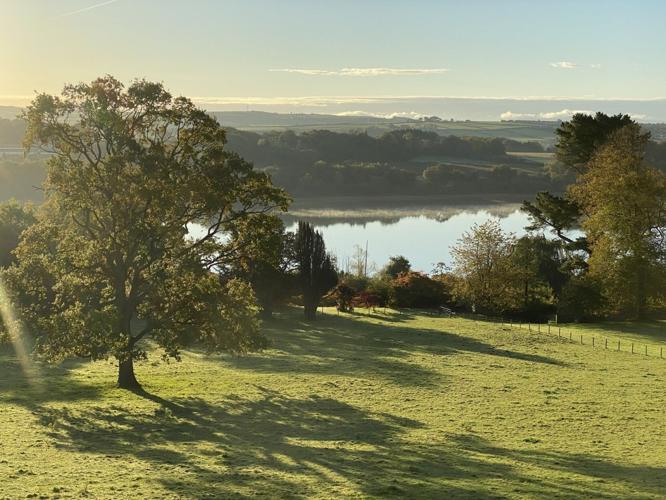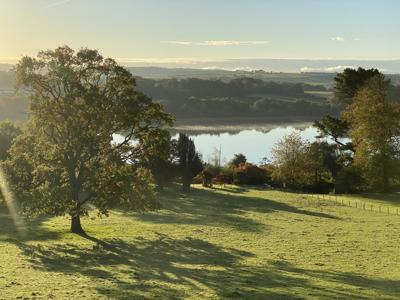As I make my way past the white Georgian mansion on the northern banks of the River Foyle, rows of towering oaks give way to rounder, cascading evergreens. Vivid bursts of pinks, reds and purples peek through the lush foliage, hinting at the botanical beauty beyond.
Located about five kilometres from the city of Derry, is one of Northern Irelandãs top arboretums. Established in the early 1600s, it was a stronghold for King James II during the Siege of Derry in 1689. And its walled garden, one of the largest on the Emerald Isle, played a key role in feeding the people of Derry during the lengthy military operation, as well as during the Great Famine in the mid-1800s.
Now, thanks to a growing interest in garden tourism, Brook Hall fulfils another role: as a popular visitor attraction.
Each year, more than five million people come to Northern Ireland. They walk the 17th-century Derry Walls around the historic centre; hike the famous Giantãs Causeway coastal path, a UNESCO World Heritage site with unique basalt formations; explore the tragic story of the Titanic, the doomed luxury liner built in Belfast; and swing for par at one of more than 90 world-class golf courses.
But todayãs travellers are also seeking new ways to experience the destination, and theyãre finding a connection to its heritage through nature and the local landscapes. For the U.K. as a whole, itãs estimated that garden tourism generates almost three billion pounds in GDP.
ãNorthern Ireland sees more economy from than golf,ã says horticulturalist Trevor Edwards, director of the Northern Ireland Heritage Gardens Trust. Heãs also my guide as we explore the countryãs green spaces. ãItãs never far to the next interesting garden, and every region has a garden trail,ã he adds.

A birdãs-eye view of Brook Hall Estate & Gardens, established in the early 1600s.
Brook Hall Estate & GardensAt Brook Hall, David Gilliland conducts personalized tours. His family acquired the estate in 1856, and over the years, they filled the 140-acre grounds with more than 1,200 rare and unusual trees and plants. More than 600 species are unique to the property. ãThe majority of specimens here arenãt native. I call it a zoo for plants,ã says Gilliland.
The diverse plantscape is courtesy of Gillilandãs great-grandfather Frank, a passionate collector of conifers, and his grandfather George, a renowned dendrologist with a love of flowering shrubs and trees from Asia and South America.
Frankãs pinetum showcases more than 100 species of conifers, including the islandãs first dawn redwood, endangered dove trees, and a giant redwood planted in honour of Frankãs birth in 1884. George, a world authority on rhododendrons, added more than 80 species of the woody plants, noted for their striking, colourful tubular blossoms, as well as dozens of species of magnolias and camellias.
ãThereãs a big push for native planting, which has its place, but when youãre trying to showcase the beauty of plants around the world, thatãs when arboretums and gardens such as ours become important,ã Gilliland says.

The neoclassical stone manor house at Mount Stewart is surrounded by 950 acres of woodlands, lawns and orchards.
Art Ward/Tourism IrelandThe next morning, I head to Newtownards, about 90 minutes east of Derry, to tour . The ivy-clad, neoclassical stone manor house, seat of the Marquesses of Londonderry for more than 200 years and now owned by the National Trust, is surrounded by 950 acres of woodlands, lawns and orchards. Much of its formal gardens was developed by Edith, Lady Londonderry, wife of the 7th Marquess, in the mid-20th century.
ãShe created what is arguably one of the best gardens youãll ever visit,ã says head gardener Mike Buffin. In spring, the landscape is blanketed with more than 15,000 tulips. The rhododendrons explode in May and June, in a kaleidoscope of yellows, reds, oranges and purples. Plant hunters introduced the ornamental species to the estate in the Victorian era.
ãBecause of Northern Irelandãs high rainfall and mild, temperate climate, we can grow a range of plants you canãt grow in gardens in the rest of the U.K.,ã Buffin points out.
Sweet-smelling bay trees, roses and hydrangeas infuse the landscape with their fragrance. Rare Chilean hazelnut trees, tropical tree ferns and New Zealand broadleaf flourish side by side with 800 giant Himalayan lilies, the largest display in the world. Mythological creatures and endearing animals in concrete, stone and topiary add whimsy to the stately surroundings.

At Mount Stewart, Edith, Lady Londonderry, created ãwhat is arguably one of the best gardens youãll ever visit.ã
Art Ward/Tourism IrelandOne of Northern Irelandãs most acclaimed heritage sites is , in the picturesque village of the same name. Located about 20 minutes southwest of Belfast, the 18th-century Georgian mansion is an official residence of the British Royal Family.
A reminder of the estateãs historic status can be seen at the gardenãs west entrance, where stone gates are topped with gilded pineapple finials. Hillsborough boasts one of the U.K.ãs earliest pineries, dating to the 1770s. During the 18th century, fashionable families would display the tropical fruit as centrepieces during dinner parties. A single pineapple could cost the modern equivalent of 5,000 pounds.
ãGrowing your own pineapples was a sign of extreme wealth,ã says garden manager Claire Woods. It was also a testament to a gardenerãs skills. Edwards notes that families would compete to see who could cultivate the best and biggest pineapples.
The 3.83-acre walled kitchen garden, built in the 1750s and renovated in the mid-2010s, first opened to the public in 2018. Manicured hedges, geometrically aligned pathways and pristine plant beds sprout with Irish-bred fruits, vegetables and flowers. Golden daffodils, purple-blue monkshood and lavender crocus bloom beneath ornamental quince trees.
A soft mist permeates the air as we wander the castleãs 100-acre grounds. Orchards brim with Irish heritage apples. Purplish bluebells, fragrant yellow azaleas and showy rhododendrons add bold splashes of colour. An allûˋe of Irish yews cuts a forest-green pathway to the castle.

Hillsborough Castle and Gardens is an official residence of the British Royal Family.
Donal Maloney/Tourism Northern IrelandãThis time of year, we get the bright colours. In summer, we get much softer flowers and foliage. That gives way to lots of lovely autumn hues. And in the winter, you see the bones of the garden, the real structure,ã Woods explains.
ãA lot of these gardens were about showing off your collection of plants. The same holds true today,ã Woods continues. ãWe want people to come and explore. And we hope they will go away inspired to grow plants as we do, to use ideas they find here, or to simply want to visit other gardens or castles.ã
Rebecca L. Rhoades travelled as a guest of Tourism Northern Ireland, which did not review or approve this article.








































To join the conversation set a first and last name in your user profile.
Sign in or register for free to join the Conversation